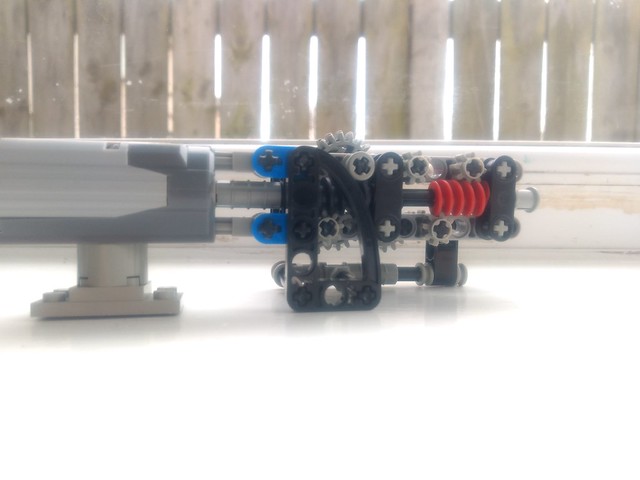Spent Paddy's Day tinkering with Technic mechanisms. I've been toying with trying to build a Mechanical Sequencer for some time - a device powered by one motor which does one thing for a little while, then does a different thing.
I've seen a couple on Eurobricks, however the ones I've seen do function A, then function B, and when the motor is reversed, they do function A in reverse, followed by function B in reverse. So I set myself the task of building one that reverses the sequence as well: A followed by B, then B reversed followed by A reversed. For those of you who are less technically minded, a practical use for this would be to use a single motor to power two-stage
outriggers on a crane - they go out, then down, and in reverse they go up then in; it would be useless if they went in first before going up when retracting.
Part of building my particular design of mechanical sequencer involved building another mechanism I've been thinking of - I'm not sure of the correct name for it but I'd call it a Directional Output Selector. This is a device that would be used to have one motor perform two functions, as long as neither of those functions ever needed to work in reverse or simultaneously. Run the motor one way and one thing happens, run it the other way and something else happens.
First up, the Directional Output Selector. Here's a video. Lego worm gears can slide along axles. This makes use of that - the worm gear will slide to one side due to its own rotation, and turn the output gear on that side when it can't slide any further.

Directional output selector. Depending on whether the motor turns one way or the other, either the blue or the white output turns.And second, the Mechanical Sequencer (video!)Like the Directional Output Selector, it relies on the sliding of worm gears. However this time the sliding is controlled. The black worm gear is connected to a string of gears which link to the underside of the red worm gear. They slide the red worm gear along slowly, causing it to move from one output to the other.

Mechanical sequencer. One output turns for a certain time, then the second output turns. Outputs turn in reverse order when motor direction is reversed.
The Mechanical sequencer isn't perfect - it doesn't turn for very long, and the gears slip a little bit because the worm gear doesn't perfectly mesh with the output gear when it meets it.. The short turning time can be worked around by gearing up or down, or both at different stages, but there probably is a better configuration of gears.
As always, there are more photos on Flickr. These are in two separate albums:
Directional Output SelectorMechanical Sequencer